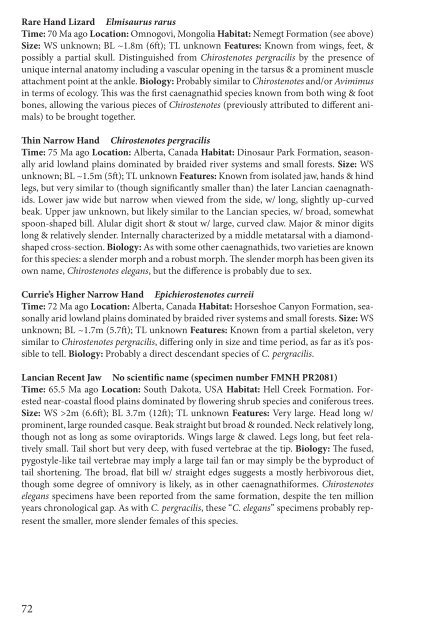You also want an ePaper? Increase the reach of your titles
YUMPU automatically turns print PDFs into web optimized ePapers that Google loves.
Rare H<strong>and</strong> Lizard Elmisaurus rarus<br />
Time: 70 Ma ago Location: Omnogovi, Mongolia Habitat: Nemegt Formation (see above)<br />
Size: WS unknown; BL ~1.8m (6ft); TL unknown Features: Known from wings, feet, &<br />
possibly a partial skull. Distinguished from Chirostenotes pergracilis by the presence of<br />
unique internal ana<strong>to</strong>my including a vascular opening in the tarsus & a prominent muscle<br />
attachment point at the ankle. Biology: Probably similar <strong>to</strong> Chirostenotes <strong>and</strong>/or Avimimus<br />
in terms of ecology. This was the first caenagnathid species known from both wing & foot<br />
bones, allowing the various pieces of Chirostenotes (previously attributed <strong>to</strong> different animals)<br />
<strong>to</strong> be brought <strong>to</strong>gether.<br />
Thin Narrow H<strong>and</strong> Chirostenotes pergracilis<br />
Time: 75 Ma ago Location: Alberta, Canada Habitat: Dinosaur Park Formation, seasonally<br />
arid lowl<strong>and</strong> plains dominated by braided river systems <strong>and</strong> small forests. Size: WS<br />
unknown; BL ~1.5m (5ft); TL unknown Features: Known from isolated jaw, h<strong>and</strong>s & hind<br />
legs, but very similar <strong>to</strong> (though significantly smaller than) the later Lancian caenagnathids.<br />
Lower jaw wide but narrow when viewed from the side, w/ long, slightly up-curved<br />
beak. Upper jaw unknown, but likely similar <strong>to</strong> the Lancian species, w/ broad, somewhat<br />
spoon-shaped bill. Alular digit short & s<strong>to</strong>ut w/ large, curved claw. Major & minor digits<br />
long & relatively slender. Internally characterized by a middle metatarsal with a diamondshaped<br />
cross-section. Biology: As with some <strong>other</strong> caenagnathids, two varieties are known<br />
for this species: a slender morph <strong>and</strong> a robust morph. The slender morph has been given its<br />
own name, Chirostenotes elegans, but the difference is probably due <strong>to</strong> sex.<br />
Currie’s Higher Narrow H<strong>and</strong> Epichierostenotes curreii<br />
Time: 72 Ma ago Location: Alberta, Canada Habitat: Horseshoe Canyon Formation, seasonally<br />
arid lowl<strong>and</strong> plains dominated by braided river systems <strong>and</strong> small forests. Size: WS<br />
unknown; BL ~1.7m (5.7ft); TL unknown Features: Known from a partial skele<strong>to</strong>n, very<br />
similar <strong>to</strong> Chirostenotes pergracilis, differing only in size <strong>and</strong> time period, as far as it’s possible<br />
<strong>to</strong> tell. Biology: Probably a direct descendant species of C. pergracilis.<br />
Lancian Recent Jaw No scientific name (specimen number FMNH PR2081)<br />
Time: 65.5 Ma ago Location: South Dakota, USA Habitat: Hell Creek Formation. Forested<br />
near-coastal flood plains dominated by flowering shrub species <strong>and</strong> coniferous trees.<br />
Size: WS >2m (6.6ft); BL 3.7m (12ft); TL unknown Features: Very large. Head long w/<br />
prominent, large rounded casque. Beak straight but broad & rounded. Neck relatively long,<br />
though not as long as some ovirap<strong>to</strong>rids. Wings large & clawed. Legs long, but feet relatively<br />
small. Tail short but very deep, with fused vertebrae at the tip. Biology: The fused,<br />
pygostyle-like tail vertebrae may imply a large tail fan or may simply be the byproduct of<br />
tail shortening. The broad, flat bill w/ straight edges suggests a mostly herbivorous diet,<br />
though some degree of omnivory is likely, as in <strong>other</strong> caenagnathiformes. Chirostenotes<br />
elegans specimens have been reported from the same formation, despite the ten million<br />
years chronological gap. As with C. pergracilis, these “C. elegans” specimens probably represent<br />
the smaller, more slender females of this species.<br />
72



